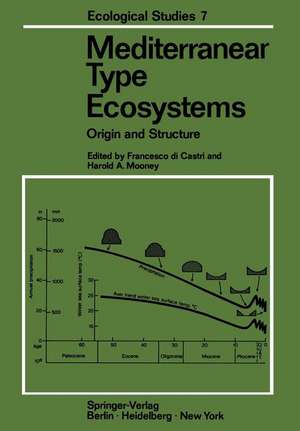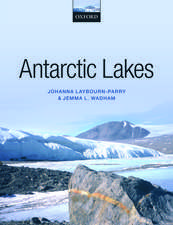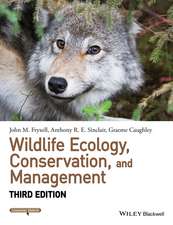Mediterranean Type Ecosystems: Origin and Structure: Ecological Studies, cartea 7
Editat de Francesco di Castri, Harold A. Mooneyen Limba Engleză Paperback – 11 noi 2011
Din seria Ecological Studies
- 18%
 Preț: 1118.93 lei
Preț: 1118.93 lei -
 Preț: 553.71 lei
Preț: 553.71 lei - 18%
 Preț: 1680.55 lei
Preț: 1680.55 lei - 18%
 Preț: 1003.38 lei
Preț: 1003.38 lei - 20%
 Preț: 1004.69 lei
Preț: 1004.69 lei -
 Preț: 480.62 lei
Preț: 480.62 lei - 5%
 Preț: 752.26 lei
Preț: 752.26 lei - 15%
 Preț: 643.99 lei
Preț: 643.99 lei - 15%
 Preț: 644.18 lei
Preț: 644.18 lei - 15%
 Preț: 652.49 lei
Preț: 652.49 lei - 18%
 Preț: 789.83 lei
Preț: 789.83 lei -
 Preț: 382.36 lei
Preț: 382.36 lei - 15%
 Preț: 643.48 lei
Preț: 643.48 lei - 15%
 Preț: 646.30 lei
Preț: 646.30 lei - 15%
 Preț: 634.32 lei
Preț: 634.32 lei -
 Preț: 384.86 lei
Preț: 384.86 lei - 18%
 Preț: 789.98 lei
Preț: 789.98 lei - 15%
 Preț: 645.14 lei
Preț: 645.14 lei - 15%
 Preț: 649.39 lei
Preț: 649.39 lei - 18%
 Preț: 1005.43 lei
Preț: 1005.43 lei - 18%
 Preț: 949.23 lei
Preț: 949.23 lei - 15%
 Preț: 649.54 lei
Preț: 649.54 lei - 15%
 Preț: 643.34 lei
Preț: 643.34 lei - 15%
 Preț: 649.71 lei
Preț: 649.71 lei - 15%
 Preț: 638.76 lei
Preț: 638.76 lei - 18%
 Preț: 957.62 lei
Preț: 957.62 lei - 18%
 Preț: 1235.25 lei
Preț: 1235.25 lei - 18%
 Preț: 962.18 lei
Preț: 962.18 lei - 18%
 Preț: 949.23 lei
Preț: 949.23 lei - 15%
 Preț: 660.68 lei
Preț: 660.68 lei -
 Preț: 397.76 lei
Preț: 397.76 lei - 15%
 Preț: 638.24 lei
Preț: 638.24 lei - 18%
 Preț: 942.31 lei
Preț: 942.31 lei - 18%
 Preț: 1232.57 lei
Preț: 1232.57 lei - 15%
 Preț: 651.34 lei
Preț: 651.34 lei - 18%
 Preț: 952.72 lei
Preț: 952.72 lei - 18%
 Preț: 1834.27 lei
Preț: 1834.27 lei - 18%
 Preț: 1229.10 lei
Preț: 1229.10 lei -
 Preț: 423.95 lei
Preț: 423.95 lei - 18%
 Preț: 948.92 lei
Preț: 948.92 lei
Preț: 649.87 lei
Preț vechi: 764.55 lei
-15% Nou
Puncte Express: 975
Preț estimativ în valută:
124.35€ • 130.10$ • 103.30£
124.35€ • 130.10$ • 103.30£
Carte tipărită la comandă
Livrare economică 03-17 aprilie
Preluare comenzi: 021 569.72.76
Specificații
ISBN-13: 9783642655227
ISBN-10: 364265522X
Pagini: 428
Ilustrații: XII, 408 p.
Dimensiuni: 170 x 244 x 22 mm
Greutate: 0.68 kg
Ediția:Softcover reprint of the original 1st ed. 1973
Editura: Springer Berlin, Heidelberg
Colecția Springer
Seria Ecological Studies
Locul publicării:Berlin, Heidelberg, Germany
ISBN-10: 364265522X
Pagini: 428
Ilustrații: XII, 408 p.
Dimensiuni: 170 x 244 x 22 mm
Greutate: 0.68 kg
Ediția:Softcover reprint of the original 1st ed. 1973
Editura: Springer Berlin, Heidelberg
Colecția Springer
Seria Ecological Studies
Locul publicării:Berlin, Heidelberg, Germany
Public țintă
ResearchCuprins
Section I: Convergence in Ecosystems.- 1. Historical View of the Concept of Ecosystem Convergence.- Section II: Physical Geography of Lands with Mediterranean Climates.- 1. distribution and Peculiarity of Mediterranean Ecosystems.- 2. Climatographical Comparisons between Chile and the Western Coast of North America.- 3. The Physiography of the Mediterranean Lands with Special Emphasis on California and Chile.- 4. Geomorphological Processes and Characteristic Landforms in the Mediterranean Regions of the World.- 5. Analogies between the Soil and Vegetation Types of Italy, Greece, and California.- Section III: Vegetation in Mediterranean Climate Regions.- 1. Structure and Function of the California Chaparral — an Example from San dimas.- 2. Structure and Functional Response of Ecosystems in the Mediterranean Climate of Australia.- 3. The Role of the Secondary Plant Chemistry in the Evolution of the Mediterranean Scrub Vegetation.- 4. Comparative Anatomy of Sclerophylls of Mediterranean Climatic Areas.- Section IV: Soil Systems in Mediterranean Climate Regions.- 1. Soil Animals in Latitudinal and Topographical Gradients of Mediterranean Ecosystems.- 2. Microbial Activity under Seasonal Conditions of Drought in Mediterranean Climates.- 3. Soil-Vegetation Relationships in Mediterranean Ecosystems of Southern France.- Section V: Plant Biogeography.- 1. The Evolution of Mediterranean Floras.- 2. History of the Mediterranean Ecosystem in California.- Section VI: Animal Biogeography and Ecological Niche.- 1. Biogeography of Soil Beetles in Mediterranean Regions.- 2. Biogeography of Pseudoscorpions in the Mediterranean Regions of the World.- 3. Parallel Evolution and Bird Niches.- 4. Ecological Convergence of the Lizard Faunas of the Chaparral Communities in Chile andCalifornia.- 5. Segregation of Lizard Niches in the Mediterranean Region of Chile.- Section VII: Human Activities Affecting Mediterranean Ecosystems.- 1. Man’s Impact on the Several Regions with Mediterranean Climates.- 2. The Human Degradation of Mediterranean Landscapes in Israel.













